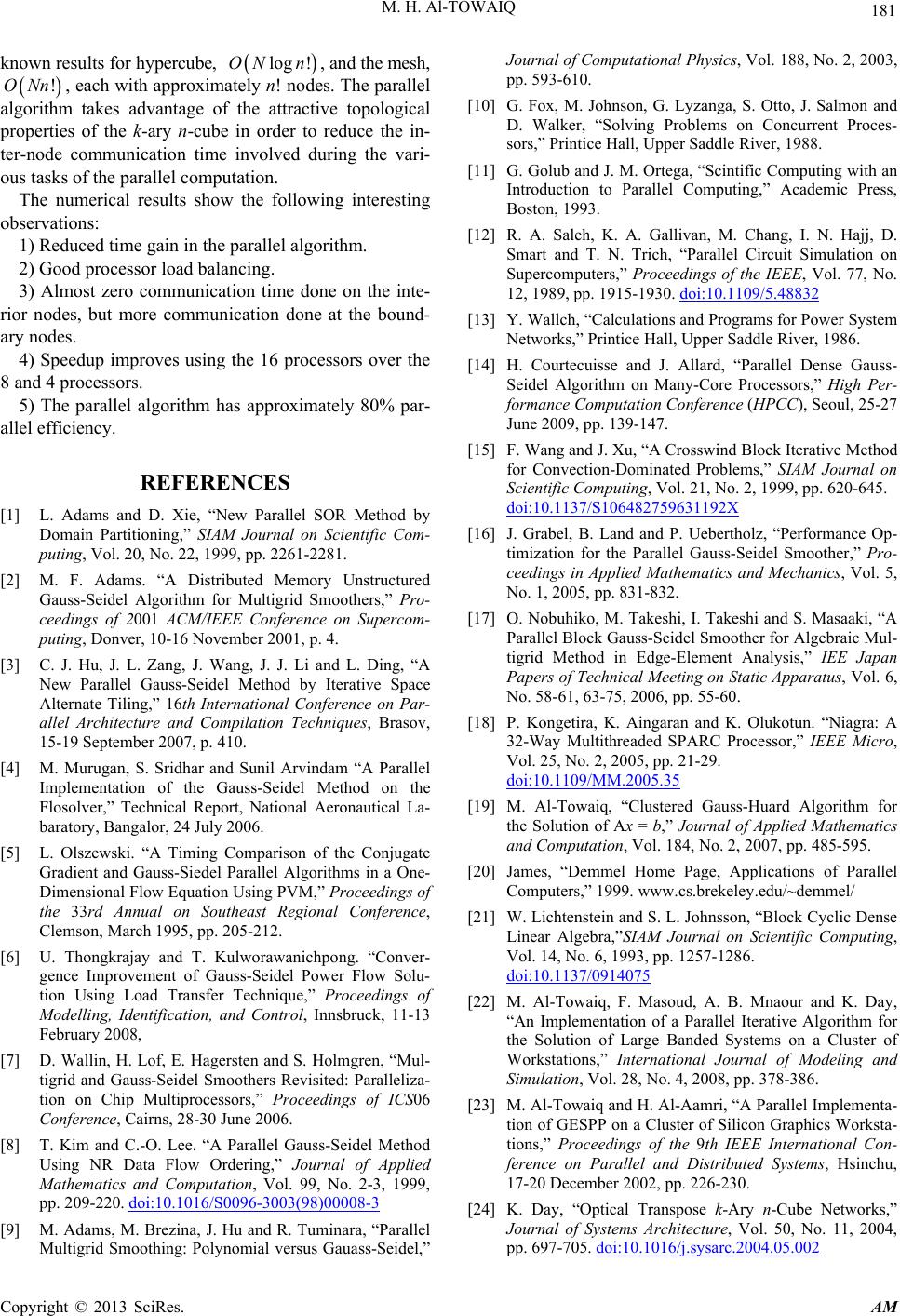
M. H. Al-TOWAIQ 181
known results for hypercube, , and the mesh,
, each with approximately n! nodes. The parallel
algorithm takes advantage of the attractive topological
properties of the k-ary n-cube in order to reduce the in-
ter-node communication time involved during the vari-
ous tasks of the parallel computation.
log !ON n
!ONn
The numerical results show the following interesting
observations:
1) Reduced time gain in the parallel algorithm.
2) Good processor load balancing.
3) Almost zero communication time done on the inte-
rior nodes, but more communication done at the bound-
ary nodes.
4) Speedup improves using the 16 processors over the
8 and 4 processors.
5) The parallel algorithm has approximately 80% par-
allel efficiency.
REFERENCES
[1] L. Adams and D. Xie, “New Parallel SOR Method by
Domain Partitioning,” SIAM Journal on Scientific Com-
puting, Vol. 20, No. 22, 1999, pp. 2261-2281.
[2] M. F. Adams. “A Distributed Memory Unstructured
Gauss-Seidel Algorithm for Multigrid Smoothers,” Pro-
ceedings of 2001 ACM/IEEE Conference on Supercom-
puting, Donver, 10-16 November 2001, p. 4.
[3] C. J. Hu, J. L. Zang, J. Wang, J. J. Li and L. Ding, “A
New Parallel Gauss-Seidel Method by Iterative Space
Alternate Tiling,” 16th International Conference on Par-
allel Architecture and Compilation Techniques, Brasov,
15-19 September 2007, p. 410.
[4] M. Murugan, S. Sridhar and Sunil Arvindam “A Parallel
Implementation of the Gauss-Seidel Method on the
Flosolver,” Technical Report, National Aeronautical La-
baratory, Bangalor, 24 July 2006.
[5] L. Olszewski. “A Timing Comparison of the Conjugate
Gradient and Gauss-Siedel Parallel Algorithms in a One-
Dimensional Flow Equation Using PVM,” Proceedings of
the 33rd Annual on Southeast Regional Conference,
Clemson, March 1995, pp. 205-212.
[6] U. Thongkrajay and T. Kulworawanichpong. “Conver-
gence Improvement of Gauss-Seidel Power Flow Solu-
tion Using Load Transfer Technique,” Proceedings of
Modelling, Identification, and Control, Innsbruck, 11-13
February 2008,
[7] D. Wallin, H. Lof, E. Hagersten and S. Holmgren, “Mul-
tigrid and Gauss-Seidel Smoothers Revisited: Paralleliza-
tion on Chip Multiprocessors,” Proceedings of ICS06
Conference, Cairns, 28-30 June 2006.
[8] T. Kim and C.-O. Lee. “A Parallel Gauss-Seidel Method
Using NR Data Flow Ordering,” Journal of Applied
Mathematics and Computation, Vol. 99, No. 2-3, 1999,
pp. 209-220. doi:10.1016/S0096-3003(98)00008-3
[9] M. Adams, M. Brezina, J. Hu and R. Tuminara, “Parallel
Multigrid Smoothing: Polynomial versus Gauass-Seidel,”
Journal of Computational Physics, Vol. 188, No. 2, 2003,
pp. 593-610.
[10] G. Fox, M. Johnson, G. Lyzanga, S. Otto, J. Salmon and
D. Walker, “Solving Problems on Concurrent Proces-
sors,” Printice Hall, Upper Saddle River, 1988.
[11] G. Golub and J. M. Ortega, “Scintific Computing with an
Introduction to Parallel Computing,” Academic Press,
Boston, 1993.
[12] R. A. Saleh, K. A. Gallivan, M. Chang, I. N. Hajj, D.
Smart and T. N. Trich, “Parallel Circuit Simulation on
Supercomputers,” Proceedings of the IEEE, Vol. 77, No.
12, 1989, pp. 1915-1930. doi:10.1109/5.48832
[13] Y. Wallch, “Calculations and Programs for Power System
Networks,” Printice Hall, Upper Saddle River, 1986.
[14] H. Courtecuisse and J. Allard, “Parallel Dense Gauss-
Seidel Algorithm on Many-Core Processors,” High Per-
formance Computation Conference (HPCC), Seoul, 25-27
June 2009, pp. 139-147.
[15] F. Wang and J. Xu, “A Crosswind Block Iterative Method
for Convection-Dominated Problems,” SIAM Journal on
Scientific Computing, Vol. 21, No. 2, 1999, pp. 620-645.
doi:10.1137/S106482759631192X
[16] J. Grabel, B. Land and P. Uebertholz, “Performance Op-
timization for the Parallel Gauss-Seidel Smoother,” Pro-
ceedings in Applied Mathematics and Mechanics, Vol. 5,
No. 1, 2005, pp. 831-832.
[17] O. Nobuhiko, M. Takeshi, I. Takeshi and S. Masaaki, “A
Parallel Block Gauss-Seidel Smoother for Algebraic Mul-
tigrid Method in Edge-Element Analysis,” IEE Japan
Papers of Technical Meeting on Static Apparatus, Vol. 6,
No. 58-61, 63-75, 2006, pp. 55-60.
[18] P. Kongetira, K. Aingaran and K. Olukotun. “Niagra: A
32-Way Multithreaded SPARC Processor,” IEEE Micro,
Vol. 25, No. 2, 2005, pp. 21-29.
doi:10.1109/MM.2005.35
[19] M. Al-Towaiq, “Clustered Gauss-Huard Algorithm for
the Solution of Ax = b,” Journal of Applied Mathematics
and Computation, Vol. 184, No. 2, 2007, pp. 485-595.
[20] James, “Demmel Home Page, Applications of Parallel
Computers,” 1999. www.cs.brekeley.edu/~demmel/
[21] W. Lichtenstein and S. L. Johnsson, “Block Cyclic Dense
Linear Algebra,”SIAM Journal on Scientific Computing,
Vol. 14, No. 6, 1993, pp. 1257-1286.
doi:10.1137/0914075
[22] M. Al-Towaiq, F. Masoud, A. B. Mnaour and K. Day,
“An Implementation of a Parallel Iterative Algorithm for
the Solution of Large Banded Systems on a Cluster of
Workstations,” International Journal of Modeling and
Simulation, Vol. 28, No. 4, 2008, pp. 378-386.
[23] M. Al-Towaiq and H. Al-Aamri, “A Parallel Implementa-
tion of GESPP on a Cluster of Silicon Graphics Worksta-
tions,” Proceedings of the 9th IEEE International Con-
ference on Parallel and Distributed Systems, Hsinchu,
17-20 December 2002, pp. 226-230.
[24] K. Day, “Optical Transpose k-Ary n-Cube Networks,”
Journal of Systems Architecture, Vol. 50, No. 11, 2004,
pp. 697-705. doi:10.1016/j.sysarc.2004.05.002
Copyright © 2013 SciRes. AM